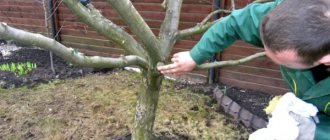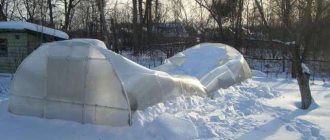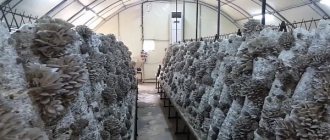The list of autumn work on a personal plot will be incomplete without pre-winter sanitary treatment of the greenhouse. Protected soil is an ideal environment for the spread of garden pests and diseases.
A closed space, lack of natural soil renewal, and rare changes in crops lead to the accumulation of pathogenic microorganisms inside the greenhouse and a decrease in fertility. Therefore, annual disinfection in the fall is mandatory. Usually it is combined with the improvement and enrichment of the soil.
Greenhouse treatment in autumn
Sufficient time is needed to prepare greenhouse buildings for the next season - this is a labor-intensive and lengthy process. The processing of greenhouses in the fall is carried out according to the following plan:
- Immediately after harvesting, preliminary cleaning is carried out in greenhouse buildings. They take out plant debris and remove the staking material - pegs, laces, trellises. If possible, all waste is burned or simply removed off-site. In this way, most pathogens of dangerous diseases and larvae of insect pests are destroyed. If you plan to reuse greenhouse equipment, it must be disinfected. Important! It is extremely undesirable to leave plant debris on the site or send it to the compost heap - this can contaminate the entire site. The exception is making compost according to all the rules for at least 4-5 years.
- After cleaning, the walls and ceiling of the building are cleaned, the path is swept and cleared of weeds. At this stage, you can disinfect the walls - wash them from the inside with the addition of “Whiteness” or tar soap. At the end, long (4-6 hours) ventilation is required. The third stage of autumn work is soil preparation. They dig up the earth, selecting the roots of weeds and large larvae. If necessary, restore the fences of the beds and level the paths. Important! It is very convenient if there is a path with a reliable coating in the greenhouse. For example, concrete or paving slabs. In this case, you will not have to constantly remove weeds and adjust row spacing.
- Prepared beds must be disinfected. For prevention, drugs with a wide spectrum of action are used. If in the previous season the plants were severely damaged by some disease, then it is better to choose a highly targeted chemical.
- In some cases, fungicides will not help. The causative agents of some diseases (primarily viruses) are resistant to even the strongest chemicals. They can only be combated by replacing the top layer of soil.
- After disinfection of the soil, organic and mineral fertilizers are applied and green manure is sowed. This will restore fertility and prepare for spring planting.
- The last stage of preparation is the necessary repairs: strengthening the frame, replacing the coating. If the greenhouse is covered with film or agrofibre, a temporary material, it must be removed before the onset of winter. Repeated use of covering material without disinfection is undesirable.
Structure processing
You can summarize the harvest only after collecting the last one from the greenhouse. Then you can start cleaning the room. All pegs that were used to tie up the plant, the tie-down material itself, and other debris are removed from the beds. The beds are in perfect order, and after that you can remove the racks and trellises . They need to be cleaned and disinfected.
How to treat a greenhouse in the fall? To disinfect racks, trellises, twine, garden tools and other equipment, you can use a strong solution of potassium permanganate or phytosporin. Everything you need needs to be soaked for 1 hour, then washed, dried and placed in specially designated places for winter storage. This procedure will help cope with pests and disinfect.
If the structure of the building is collapsible, the polycarbonate must be removed and processed so that no pathogenic microorganisms remain on it.
If the plants that were grown in the greenhouse were susceptible to any disease, all tops and other vegetation collected from the beds must be completely destroyed. If nothing like this has happened to your vegetable crops, the greens can be used to fill the compost heap.
Project, drawings, design and installation of a winter greenhouse with your own hands
Frame and cover
After the last harvest is harvested from the greenhouse, they begin to restore it. Any structure, any material, when exposed to the sun, frost and wind, loses its original appearance and can crack, burst, or rust. The same thing can happen with the greenhouse frame. Any damage found, be it rust or a crack, must be repaired and painted.
As for how to wash a polycarbonate greenhouse in the fall, undamaged areas of the frame should be washed with warm soapy water. It is advisable to do this procedure both in autumn and spring; both from the inside and from the outside. The soap solution is then removed from all surfaces with a damp cloth. Thus, the question of how to wash a polycarbonate greenhouse in the fall can be considered resolved.
For cleaning, use only non-abrasive detergents , rags or soft sponges. This will help maintain the smoothness of the coating, avoid scratches, and subsequent destruction of the surface.
When carrying out wet cleaning using a soap solution, it is necessary that it cannot get on the soil.
Soil preparation
In buildings or structures where the soil is protected, it must be regularly disinfected or partially replaced. If you need to replace the soil, then 9 cm of the top layer is enough - it is removed . In its place you need to lay a new layer of healthy soil.
Treatment of the soil in a polycarbonate greenhouse in the fall, if it is not changed, includes disinfection. The following solutions are recommended for this:
- iron sulfate 3%;
- copper sulfate;
- chlorine and lime;
- boiling water for watering the soil.
If you need to prepare the soil and this requires chemicals, such preparation should only be done in the fall. Under no circumstances should you treat the soil in the greenhouse with chemicals in the spring - this is dangerous for the plants .
If the greenhouse is completely processed, they deal directly with the soil. Organic fertilizers are added to it and dug up along with the old layer of soil.
How to clean the greenhouse after harvesting
Autumn work begins immediately after harvesting. It is important to completely get rid of plant and household waste: fruit-bearing plants and weeds are removed by the roots, equipment that has become unusable is disposed of. Barrels and drip irrigation systems are prepared for the new season: they check their functionality and repair them if necessary. This will save time in the spring.
At this stage, rakes, root removers, and garden forks will come in handy.
Important! If you practice repeated planting (for example, after harvesting cucumbers, you sow the beds with green crops), before re-seeding, immediately clear the area of plant debris and unusable equipment. The faster you remove and burn the trash, the less chance you give pests and diseases to spread throughout the area.
After cleaning, the frame is disinfected. If we are talking about a wooden or metal film greenhouse, then after removing the coating, thoroughly clean the base from the remains of old paint and rust, remove the twine or garter cords. Then they are treated with any strong disinfectant (formalin, concentrated bleach solution). This gets rid of mold and mildew.
It is useful to treat the metal parts of the frame with an anti-rust preparation and paint it. It is recommended to impregnate a wooden structure with a special antiseptic (for example, Senezh Ecobio). It will save the tree from rotting and the spread of mold.
How to treat a polycarbonate greenhouse in the fall
It is more difficult to disinfect a polycarbonate greenhouse: the coating is replaced on average once every 5-6 years. Therefore, it is possible to thoroughly process the frame without damaging the polycarbonate only with the use of a sulfur bomb.
Fumigation with sulfur smoke perfectly destroys pests and major pathogens. A sulfur bomb for a polycarbonate greenhouse will help get rid of spider mites, whiteflies, pathogens of late blight and root rot. The remaining sulfur will go into the ground, improving the chemical composition of the greenhouse substrate.
To effectively use a sulfur bomb, you must remember the following:
We recommend reading:
Decorative moss: varieties where it is used
- One checker is designed for an area of 5 m3. For an average greenhouse 3x6 m you will need at least 8-9 checkers. Calculate the correct dosage.
- During fumigation, doors and vents must be tightly closed and cracks sealed.
- The checker smolders on average for about an hour, but do not rush to open the doors: the longer you keep the doors closed, the more reliable the disinfection will be. The minimum period is 4-5 hours.
- Before lighting the bomb, coat the metal parts of the frame with a layer of oil or grease to protect against oxidation and corrosion.
- When working with a smoke bomb, use protective equipment (respirator, gloves).
Polycarbonate sheets are first washed with soapy water using brushes, then treated with a fungicide solution (potassium permanganate, phytosporin). You can prepare a concentrated solution: it is guaranteed to cope with pathogens.
Disinfection of the frame and cover of the greenhouse
Film greenhouse
It is not recommended to leave the film on the greenhouse until spring. It must be cleaned and removed before the onset of cold weather, otherwise it will tear and become frayed during the winter.
A soap solution is best for cleaning film coating. After using it, the film can be treated with a solution of copper sulfate. Then it must be allowed to dry, then carefully removed, folded and stored in a dark place. Don't be afraid to leave the greenhouse open for the winter. The ground covered with snow in the spring will receive enough moisture for the future harvest.
Glass greenhouse
Glass greenhouses can also be washed well with ordinary soapy water. You can also use special glass cleaning products. The surfaces of such a greenhouse should be washed both inside and outside.
You need to “walk” especially carefully in those places where dirt accumulates. You can wash it off with a strong stream of water from a hose. For disinfection, the glass walls of the greenhouse should be treated with a pink solution of potassium permanganate.
If the glass in the greenhouse is damaged, they need to be replaced. The cracks in the frames must be sealed with putty. Do not leave the greenhouse until spring if it is not finished. Dirt and plant debris are an excellent breeding ground for fungus and other pathogens.
Polycarbonate greenhouse
The easiest way to treat such a greenhouse is to use dishwashing detergent or baking soda. You can also use 40% formaldehyde (250 g per 10 liters of water) or bleach solution (400 g per 10 liters of water).
When washing a polycarbonate greenhouse, it is advisable to use sponges, rags or soft brushes, since coarse abrasive particles can scratch the soft surface of the roofing material. Don't forget about the supports - they also require processing. Thus, it is recommended to treat wooden structures with a 5% solution of copper sulfate, which will protect their surface from the growth of moss and lichens.
Preparing for the next harvest
In greenhouses, there is no natural renewal of the fertile soil layer, so additional measures cannot be avoided. After harvesting the last crop, it is necessary to apply organic and mineral fertilizers. To improve the composition and structure of greenhouse soil, use:
- organic fertilizers - manure, compost, rotted leaf litter;
- peat with a slightly acidic reaction;
- river sand;
- straw or hay;
- ash.
When digging, store-bought mineral complex mixtures (such as “Autumn”) are added.
It is damper in a polycarbonate greenhouse, and freezing of the ground begins later than in greenhouses with removable cover. Therefore, it is not recommended, for example, to mulch the ground with straw “in winter.” This leads to the formation of mold.
A good way to increase fertility is to sow mustard, clover, phacelia or any other green manure. If the harvest is harvested early (late August-early September), then green fertilizers can be sifted twice.
Important! If this is your first time sowing green manure crops, follow these rules:
- The seeds are not planted deeply, but are left on the surface of a well-loosened bed. After sowing, abundant watering is required.
- Do not spare the seeds; the thicker the mustard sprouts, for example, the better.
- After the plants reach a height of 20-25 cm, you need to embed them into the soil with a flat cutter or hoe. If you meet the deadline, re-sow immediately.
Do I need to put snow in the greenhouse?
At the end of winter, or better yet in early spring, when there is still a lot of snow around, you need to throw as much snow as possible onto the ground. It is not recommended to bring snow earlier.
If the ground is covered earlier, the pests will quickly come to life and begin their destructive activities. In addition, bare soil will be better frozen, which will also kill many pests.
Finally: preparing the greenhouse for winter in the fall will help you get an excellent harvest, and you shouldn’t leave everything until spring. In the spring, without this, there will be a lot of work, so don’t waste time, redo all the important things today.
How to treat greenhouses in the fall, choice of products
In the fall, you can use various preparations, even aggressive chemicals, since during the winter the most dangerous elements usually have time to be neutralized. But we should start with more gentle measures.
- If prevention is needed, use steaming. Prepare boiling water at the rate of 2-3 liters per m2 and water the ridges. Afterwards, cover the beds with film; you can use an old and not very clean one.
- A more radical measure is the use of copper sulfate. Its solution is used when washing a greenhouse and for disinfecting the soil. Using copper sulfate you can get rid of insect pests and fungal pathogens.
- Iron sulfate will get rid of harmful microorganisms, but will not spare beneficial microflora. After disinfection, you will receive a “dead” greenhouse, unsuitable for gardening for a year.
- Disinfecting solution "Persel 6" will destroy mold, pathogens of fungal diseases, and disinfect ridges and greenhouse frames. The manufacturer recommends continuous spraying of greenhouse buildings and guarantees complete decomposition of the drug in the ground.
Soil cultivation and replacement of the top layer
The most reliable way to get rid of pathogens and pests is to remove the top layer of soil (7-8 cm) and remove it from the greenhouse. Ideally, take it outside the site.
But this is not so easy to do. First of all, you will unload at least 2 m3 of soil from an average greenhouse. Where to take such a mass of soil? And leaving the source of infection on the site is dangerous: the infection will continue.
Then, the old soil must be replaced, that is, the same amount of fertile soil must be added to replace the one that has served its purpose. You need to be careful when purchasing soil mixtures: even in stores they sell used substrate that is contaminated and not suitable for growing plants. Yes, and it is expensive to purchase several cubes of soil, but some pathogens have to be gotten rid of only by completely changing the soil. First of all, this applies to tobacco and cucumber mosaic viruses, which can completely damage a greenhouse. No drugs—not radical chemistry, much less folk remedies—have an effect on these diseases. At best, you will collect 5-10% of the possible harvest. Therefore, do not allow contamination of the greenhouse substrate, do not neglect crop rotation and autumn disinfection. And replace the soil at least once every 3-4 years.
Preparations for treatment
Disinfection of a greenhouse in the fall is completed by treating it with chemicals or biological products. In this case, chemical-based preparations are used for treatment only in the fall . If you need to treat the room in the spring, only biological products are suitable.
How to build a greenhouse with your own hands
In autumn, the following common processing methods are used:
- fumigation with a sulfur bomb;
- fumigation with cuttings sulfur;
- pollination with bleach;
- irrigation with copper sulfate.
If the frame of the greenhouse is made of galvanized steel, fumigation in it cannot be carried out using sulfur. And all because sulfur dioxide released during combustion accelerates the process of metal corrosion.
If the frame of the greenhouse is made of wood or painted, any fumigation can be carried out in such a room.
Fumigation with a sulfur bomb is one of the methods of disinfection, which should be carried out while wearing protective equipment. The most common of them are gloves, goggles, a gas mask or respirator, and thick clothing. The gas released is very toxic; in order to have an effect, all doors and transoms in the room must be closed.
The amount of substance required per 10 cubic meters is 600 grams. Finished checkers should be placed evenly around the entire perimeter of the room, using metal sheets or stone stands. Checkers need to be set on fire on the opposite side of the entrance. After all the checkers are set on fire, you must leave the room immediately to avoid poisoning. Doors must be closed tightly.
This method is used in rooms whose frames are made of plastic pipes or wood. It is acceptable to use this procedure in a greenhouse with a metal frame , if it is covered with a protective polymer layer and painted in production.
Fumigation with cutting sulfur is carried out only after the use of protective equipment. Only they can protect against the toxic effects of sulfur smoke. During and after processing, all windows and doors in the greenhouse must be closed, only then the gas released will be of the required concentration and will actually cope with all the tasks.
How to treat the soil in a greenhouse in the fall? For processing, you need to buy cuttings of sulfur at the rate of 1 kg of sulfur per 10 cubic meters of area. To prepare the mixture, you need to mix charcoal and crushed sulfur, taken in equal quantities. Place the resulting mixture on metal baking sheets, which are inserted into metal basins, and spread evenly throughout the greenhouse. The substance should be set on fire and the building should be left immediately to avoid poisoning.
Premises treated with sulfur can only be opened after five days. After this, they need to be ventilated for three whole weeks. During this time, no work is carried out in the greenhouse, since the fumigation procedure disinfects not only the building, but also the soil.
Greenhouse farming: business plan, investments, profitability
Polycarbonate greenhouses can be treated with bleach in the spring. This treatment can be done in the fall. To properly prepare the solution, you need:
- 400 g of bleach;
- 10 liters of water.
Mix everything and leave for 4 hours. It is used for the structure of a greenhouse and for the soil in it, spraying occurs using a spray bottle. After thorough treatment, it is recommended to close the room for 2 days, then open and thoroughly ventilate. This solution is suitable for disinfecting equipment.
Treating a greenhouse with copper sulfate is another method of disinfection. Like the previous method, it is used both in spring and autumn. To prepare the solution you will need:
- 75 g of copper sulfate;
- 10 liters of water.
The ingredients are combined and the solution is mixed. If the plants in the greenhouse had diseases, you need to take twice as much copper sulfate, that is, 150 g. All buildings and soil must be treated with the solution, using a spray bottle.
Treatment of greenhouses and greenhouses from pests and diseases in the fall without replacing the soil
Unlike mechanical replacement of the greenhouse substrate, preventive treatment against pests is carried out annually. To do this, you can use different methods: from unsafe chemicals to gentle folk remedies. The prepared solution is poured onto the beds using a watering can or sprayed with a spray bottle. If radical drugs are chosen, be sure to use gloves, respirators, and other protective equipment.
We recommend reading:
We make a decorative well at the dacha with our own hands
Chemical Selection
To destroy pests, a variety of chemical compounds are used: from safe and permitted ones, such as copper sulfate or karbofos, to toxic ones, such as formaldehyde or bleach.
Before using dangerous poisons that will inevitably contaminate the area, determine what kind of scourge you are going to fight. Surely, in order to remove wireworms or beetles, you should not turn your summer cottage into a chemical waste dump. It is enough to use something safe both for the plants and for the gardener who will spray.
To apply to the soil, use less concentrated preparations. So, if you use a four percent solution of copper sulfate for a garden bed in a greenhouse (350-400 g of crystalline powder is dissolved in a bucket of water), you are guaranteed to get rid of any pests. But immediately after such disinfection, planting cannot be done. The land must be restored for at least a year.
Concentrated, burning compounds can be safely used to disinfect the frames and coverings of greenhouse buildings.
We list the most well-known chemical preparations for autumn treatment:
- Copper sulfate. For soil, use a solution of low concentration (1-1.5%). To disinfect greenhouse buildings, it is permissible to use a more saturated solution of the drug (3-5%). Destroys pests, pathogens of fungal and bacterial diseases.
- Terradox. An effective chemical against soil pests. It will help cope with mole crickets, ants, wireworm larvae, and onion flies. The drug is applied immediately after harvesting: the granules are embedded to a depth of at least 5-7 cm.
- Previkur. Excellent fight against any fungi, mold, bacterial diseases. Apply several times during the summer, the last spraying is carried out before the onset of stable negative temperatures.
Biologically active agents
Such preparations do not accumulate in the soil and do not pollute the environment. They are effective against blackleg, bacterial rot, and mold fungi. It is recommended to spray the plantings repeatedly with biologically active preparations during the summer season and be sure to treat the beds in the fall.
The most effective means:
- Trichodermin. In the summer, they add it to the holes when planting, water and spray the plants against root rot. In the fall, greenhouse beds are watered with a saturated solution (100-150 ml of trichodermin is dissolved in a bucket of water).
- Fitosporin. Available in powder and paste form (“black” phytosporin). Paste is better suited for autumn processing: it contains natural additives that increase fertility. Prepare a solution, perhaps even more concentrated than the manufacturer recommends in the instructions, and pour the soil generously. Using phytosporin paste, you can restore fertility after using aggressive chemicals.
- Baikal EM 1. An excellent composition for suppressing pathogenic soil microorganisms. Also used to speed up composting.
Folk methods and means of struggle
If you prefer to use folk remedies, do not use chemicals: after factory-made insecticides, no proven folk recipe will work. The most famous recommendations:
- herbal infusions - tobacco, garlic, onion, mustard;
- thermal soil treatment - steaming with boiling water;
- using solutions from what is at hand (baking soda, vinegar).
Wooden fortifications
It is best to disinfect wooden structures with copper sulfate or Bordeaux mixture. Prepare a solution with a concentration of 8-10%, then cover the wooden base. To enhance the effect of the product, the surface must first be treated with bleach. After all the procedures, let the wood dry and then cover it with freshly slaked lime.
Wood dries out over time, and it is simply impossible to treat cracks of different sizes, especially small ones. In this case, you can use the sulfur fumigation method, which is especially convenient for non-dismountable greenhouses. You need to do the following:
- Seal all cracks in wooden beams.
- To enhance the effect of the procedure, you should moisten the internal surfaces of the greenhouse with water.
- When fumigating, you need to wear rubber gloves, and to protect your eyes and respiratory organs, use a gas mask and goggles, since when the substance burns, it releases compounds harmful to the human body.
- For this method, sulfur or sulfur blocks are used in the following proportion: per 10 cubic meters. - 1 kg of sulfur or 600 g of sulfur bombs.
- The product must be crushed and mixed with coal.
- Place metal braziers filled with the mixture in containers with water (for fire safety) and place them throughout the entire area of the greenhouse.
- Then set the mixture on fire. With the doors and windows closed in the greenhouse, the substance should smolder for 5 days.
- After this, the greenhouse should be well ventilated. After the procedure, the polycarbonate coating should be washed with a soda solution.
This method can be used to disinfect a greenhouse with a PVC structure; for metal frames, the use of such measures is undesirable. When sulfur burns, substances are released that contribute to the development of the corrosion process of the metal. Fumigation is carried out in structures made of glass, film, and polycarbonate.
All coatings are disinfected with solutions: glass and polycarbonate coatings - with bleach, polycarbonate panels - with potassium permanganate, film - with a 4% solution of copper sulfate. Then the material is allowed to dry and stored.
If signs of plant disease and the presence of harmful insects were found in the greenhouse, the means used to tie up the tomatoes and wooden supports should be burned. If these were plastic or metal pegs, you need to soak them for half an hour in a manganese solution or in a product such as Fitosporin. After this, they need to be rinsed, dried and stored.
How to treat a greenhouse against late blight and whitefly
Late blight is a common disease that can negate all your worries about the harvest. The causative agent of the disease tolerates low temperatures well, so special control measures cannot be avoided.
- Remove and burn all plant debris and unusable equipment.
- Dig up the ridges.
- Water the beds with a solution of oxychome or Bordeaux mixture.
- You can use Ridomil Gold, a reliable chemical against late blight and fungal diseases.
- In the worst case, you will have to replace the top layer of soil. If this is not possible, carry out liming or chlorination.
- Sulfur fumigation is effective against late blight.
Whiteflies should be combated throughout the summer season. In the fall, Biotlin, Fufanon, Fitoverm help well. If the preliminary stages of preparation for winter are carried out correctly (the ground and greenhouse buildings are disinfected with a sulfur bomb, treated with chlorine-containing preparations), then there will be no need to take special measures against whiteflies.
Preparing the soil for winter: treating against diseases, digging, replacing, sowing green manure
Treating the soil against pests is very important for properly preparing the greenhouse for winter. In addition, it is necessary to dig, replace the top soil layer (if necessary) and sow green manure.
Advice! It is optimal to do autumn soil preparation at the end of September, in the first half of October. It is very important to be in time before the first frost!
Digging the soil
To achieve maximum efficiency in soil disinfection, it is necessary to first dig up the area in the greenhouse.
You need to dig up the soil using the bayonet of a shovel . At the same time, after digging, there is no need to disassemble clods of earth and loosen them.
In addition to the fact that spraying the soil with fungicides will be the most effective, the soil will freeze better in winter, which will have a positive effect on the elimination of pathogens and pests.
Soil disinfection
The most important stage in preparing a greenhouse for winter and the new dacha season is preventative tillage of the soil against diseases in the fall. After all, it is easier to prevent them by spending a little time on prevention, rather than then spending energy on eliminating the disease, treating plants and saving the harvest.
Important! As noted above, when using chemicals, you must follow safety precautions: use personal protective equipment, do not stay in the room for more than 5-10 minutes, follow the instructions, and then thoroughly wash your hands, face, and mouth.
To disinfect soil to prevent diseases, you can use:
- Chemical fungicides , for example, preparations Hom, Oxychom, Quadris, Bravo, 1% copper sulfate (100 grams per 10 liters of water), Bordeaux mixture.
- Biological preparations , for example, Fitosporin-M, Baikal EM1, Trichodermin, Baktofit.
Advice! If the plants in your greenhouse area have not previously suffered from diseases, then it is better to use biological preparations, because they are safer, and also heal the soil and restore soil fertility.
At the same time, to achieve the greatest efficiency, it is recommended to re-cultivate the soil after 2 weeks.
If the plants in your greenhouse have been exposed to diseases, then the following preparations can be used for effective treatment in the fall:
- Against late blight, you can treat the soil with a solution, for example, Hom, Abiga-Pik, Consento, Revus, Fitosporin-M, 3% Bordeaux mixture.
- To combat powdery mildew, you can shed the soil with a solution of Topaz, Gamair, Quadris, Tiovit Jet, Fitosporin-M.
- Against brown spot (cladosporiosis), you can use Hom, Fitosporin-M, Pseudobacterin-2, Polyram, 3% Bordeaux mixture.
- against fusarium in the fall with Oxyx, Trichofit, Gamair, Energy, Previkur.
- For treatment against root rot, you can use the drugs Trichodermin, Baktofit, Gamair, Pseudobacterin-2, Planriz.
By the way! As already noted in this material, sulfur bomb perfectly disinfects the soil.
Important! If you use any chemical fungicides, then after them you must definitely restore the soil microflora, for example, using Fitosporin or Baikal EM1, Baktofit.
Replacing the top fertile layer
In the soil under greenhouse conditions, over time, fertilizers, remnants of fungicides, insecticides accumulate, and if disinfection is insufficient, pathogens accumulate. Therefore, once every 3-4 years it is recommended to replace the top fertile layer of soil in the greenhouse (the first 10-15 centimeters).
Replacing the soil improves the quality of the soil, minimizes the risk of developing diseases and breeding pests (however, it is not a complete guarantee of this!).
The old soil layer can be spread out on your site, but if you are sure that the soil is of poor quality, then it is better to take it somewhere outside your site.
In place of the old soil, you can bring regular soil from your site. But it is better to use a mixture to create a fertile soil layer: peat, humus or compost, sand (all ingredients in equal proportions). It is also advisable to add ash to the mixture (200 grams per square meter).
Note! If the procedure is not possible for you, then you can do without replacing the top layer of soil in the greenhouse and simply spread the above ingredients on the surface (or better yet, dig up the area with them).
Sowing green manure in a greenhouse
Green manure is very useful for any soil in your garden, including in a greenhouse. Sowing green manure will bring many benefits: they loosen the soil, improve its air exchange, saturate the soil with nitrogen and other useful substances, and promote soil disinfection. Therefore, it is highly recommended to carry out such preparation of the soil in the fall for winter and the next summer season.
It is optimal to sow green manure at the end of September or at the beginning of October. If you don’t have time to plant them at the right time, you can do winter sowing in November.
For a greenhouse, it is optimal to sow the following green manures:
- white mustard;
- Vika;
- rye;
- alfalfa;
- phacelia.
You can sow seeds simply by scattering them around the perimeter of the structure. Or you can make furrows and plant green manure in them, and then seal them with a rake.
After planting, you should water the soil (it is more effective to use not just water, but a solution of Fitosporin).
When sowing in early autumn, it is necessary to regularly water the soil for 15 days (preferably every day). Or mulch with compost or agrofibre to retain moisture.
At the end of autumn, it is necessary to check the condition of green manure. If they have grown enough, then you need to cut them at ground level and leave them on the site. If they have grown quite a bit, then you can leave everything as is for the winter.
Important! It is necessary to sow green manure in a greenhouse in the fall after disinfecting the structure and soil (i.e., after fumigation with a saber or spilling a solution of a chemical fungicide). If planted before such treatment, the green manure will die.
Application of organic fertilizers
If you have a greenhouse growing vegetable crops that love fertile soil, for example, tomatoes, cucumbers, eggplants, peppers, etc., then it is recommended to use fertilizers in the fall. It is advisable to fertilize the soil if you have not replaced the topsoil.
Organic fertilizers are suitable - compost, humus (1 bucket of organic matter per square meter of area). Afterwards you need to dig up.
How to prepare a greenhouse and greenhouse for winter
So, preparing a greenhouse or greenhouse for winter necessarily includes:
- cleaning up plant debris;
- disinfection of soil and greenhouse frame;
- improving the structure and fertility of the substrate.
These are mandatory activities that must be carried out before the onset of winter. You cannot postpone processing until spring: you simply may not have time to do everything before April-May - the time of active planting and caring for plants. In addition, many actions (fumigation with a sulfur bomb, spraying with vitriol) require a break in work for several days. During the hot spring season, the gardener does not have these days.
If there is time left in the fall, you can do pre-winter repairs and strengthen the frame, and think about a system for throwing snow off the roof.
Thoughtful autumn work is the key to good harvests and longevity of greenhouse buildings. Allocate enough time, plan your workload, and working on your garden plot will bring you benefit and joy.
How to disinfect soil before winter
Bacillus subtilis is considered an effective and more useful means for disinfection. It contains the drug "Fitop-Flora-S".
Many summer residents fumigate with sulfur: 50 g of sulfur per m² of area with the addition of kerosene.
In the greenhouse, close all the windows, plug the cracks, and put on protective clothing. Light the sulfur and kerosene on fire and quickly go out into the air, tightly closing the door behind you. The procedure is performed at a temperature of +12°C.
This method is good because it disinfects both the soil and everything inside the greenhouse.
But this method has a drawback: if the structure is on a metal frame, then you cannot fumigate it with sulfur, it will simply “eat” it.
Gardeners often use urea to disinfect the soil: completely dissolve 50 g of urea in 10 liters of water. Water the beds, aisles, and row spacing with the resulting solution.
You can use a smoke bomb. With this processing method, fungal pathogens die, as well as bacteria that carry infections, almost all pests, and mold disappears.
Fumigation with a sulfur bomb:
- Before fumigation, wash the entire structure from the inside, using water and laundry or tar soap.
- Use a spade to dig up the soil so that all soil pests are killed. (Beneficial bacteria also die along with them, so they will need to be restored again).
- Place the sulfur bomb on a brick or other stand, set it on fire using a paper tow, and quickly go out into the air.
- You can go inside the structure only after 5 days.
- After fumigation, rinse everything again and ventilate the greenhouse.
To restore soil fertility, it is treated with such preparations as “Fitosporin-M”, “Baikal EM1”, “Azotofit”.
What pathogenic organisms can survive winter in a greenhouse?
Disinfection of the greenhouse is necessary, since the plants growing there attract many insects, which not only spoil the crops and shoots, but also carry dangerous viruses and fungal spores. These pests can be dangerous not only for plants, but also for humans. If you pay insufficient attention to cleaning the greenhouse in the fall, then next year the soil in the greenhouse, and consequently the plants, will be infected with serious diseases, such as scab, olive spot, powdery mildew, late blight, anthracnose, etc. The carriers of these diseases are aphids. On young shoots it secretes a liquid on which fungi subsequently multiply. In addition, she lays eggs on the leaves, which can easily survive the winter, and in the spring they hatch into larvae. Also harmful are whitefly larvae, which can withstand temperatures down to -5. To get rid of them, you can try lowering the temperature in the greenhouse or using chemicals. In a poorly cleaned greenhouse, in places where there is a large accumulation of dirt or dust, as well as in cracks, spider mites, which are one of the main destroyers of greenhouse plants, can survive the winter. Everyone knows slugs, which are very voracious; during winter they remain in the top layer of soil and can easily wait there until spring, so when cleaning the greenhouse you should remove the top layer of soil. Against the nematode, which climbs to a depth of 20 centimeters and destroys plant roots, various chemicals or smoking with sulfur are mainly used. Reference! Also, many fungal, viral and bacterial infections can survive the winter, which can be dealt with by thorough sanitary cleaning and the use of various chemicals.
General recommendations for preparing a greenhouse for winter and the new season
In general, everything is described above about how to treat a greenhouse in the fall and prepare it for winter, but I would like to note a few more features and rules for caring for the structure in the autumn-winter period:
- It is necessary to treat not only the greenhouse and the soil with fungicides, but also the tools that are used in it (secateurs, rake, shovel, hoe, saw, etc.). After all, if they are not disinfected, they can become a source of infection. After processing, you need to move them to a dry, closed room.
- If the reliability of the frame does not inspire confidence, then at the end of autumn you can strengthen the frame so that it does not collapse under the weight of snow. The easiest way is to place wooden or metal supports inside the structure.
- Also, if the structure does not seem reliable, then in case of heavy rainfall it is recommended to remove snow from the roof surface.
- In winter, the door to the greenhouse must be closed so that wind and bad weather do not damage the structure. However, if the manufacturer of the building recommends leaving the door open for the winter, then it is better to follow this advice (but again, if your region has very frosty winters and strong, cold winds, then it is better to open only the window and securely fix it).
- At the end of winter or early spring, it is recommended to throw snow into the greenhouse so that the soil is saturated with melt water. Bringing snow earlier is not recommended, because the ground covered with warm snow is more favorable for wintering pests. In addition, soil without snow freezes better, which is very good for preventing pests and diseases.
Autumn is a time of intensive preparation for winter and caring for the garden after harvest. We should not ignore greenhouse structures and greenhouses, because they help us get a good and tasty harvest of vegetables. Also, don’t put it off until spring; it’s much more efficient to do everything in the fall. Besides, there is so much to do in the spring, so you will spend your time and energy rationally.
Replacing or disinfecting soil
During cleaning in the greenhouse, the soil is replaced and disinfected. This is a labor-intensive operation that requires the greatest effort. Because of this, many gardeners ignore such an important point in preparing a greenhouse in the fall, but in vain... Renewed soil directly affects the quality and quantity of the future harvest.
Therefore, it is recommended to change the soil every year, and specifically in the fall, since there is more free time at this time. First, you need to treat the top layer of soil in the greenhouse with chemicals, thereby removing harmful bacteria and toxic microelements remaining in the ground. Then use a shovel to remove the layer of soil and transfer it to a free area of the site, or pour it under fruit trees.
Further, there are two options for replacing the land:
Option No. 1. You can purchase new soil in a special store, and this will be the optimal solution for a vegetable grower. True, purchasing it can cause difficulties, since it is not sold in such large quantities everywhere.
Option No. 2. Prepare the soil yourself. But first you need to find out the chemical composition of the soil, its acidity, and then decide which constituent elements to select for the future soil. The ratios of the components introduced may vary, depending on what will be grown in the greenhouse structure, but usually peat, humus, sand and ash are mixed. You should also purchase fertilizers in sufficient quantities and mix them properly with the soil.
Attention! Although the option of purchasing land in a store seems to be the fastest, when purchasing you can stumble upon unscrupulous sellers and end up with land that was already used in the previous season.
Before updating the ridges, the greenhouse must be disinfected with the necessary means and fumigated with sulfur. When digging up the soil, fertilizers and copper sulfate are added to it to prevent the growth of fungus and mold.











